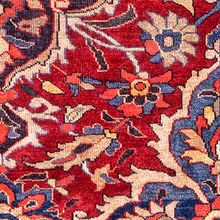Ferdos Rug
| Ferdos Rug | |
|---|---|
 Design of Ferdos Rug (Rugman) | |
| General information | |
| Name | Ferdos Rug |
| Original name | قالی فردوس |
| Alternative name(s) | Ferdos Carpet |
| Origin | |
| Category | Village |
| Technical information | |
| Common designs | Geometric, Tree |
| Common colors | Red, Begie, Blue |
| Dyeing method | Natural, Synthetic |
| Pile material | Wool |
| Foundation material | Cotton |
| Knot type | Asymmetrical (Persian) |
Ferdos rugs originate from Ferdos, a small town in the Province of Khorassan in northeastern Iran. Rug weaving in Khorasan goes back thousands of years. Known for their beautiful hand made traditional rugs, Ferdos was also the birthplace of Ferdowsi, one of Iran's greatest poets and scholars. Ferdos boasts the first tribal members to weave traditional rugs for personal use as well as for trade. Even today, the Ferdos villagers produce the finest quality traditional rugs with the same marvelous technique that they’ve been using for centuries. Jufti knots are seen in traditional rugs from this region. They are like the Persian knot with depressed warps but the knot loops around two warps at a time rather than one.
History
Materials
Foundation and Pile
Techniques and structures
Color and dyeing
Motifs and Designs
The medallion, palmette, and Minakhani (rosette-linked trellis) designs were especially popular in the older weavings. After the war rugs have a simple allover or medallion design, or, at times, an Open Field style.[1]
Weaving techniques
See also
References
- ↑ Moheban, 2015, p.189
Bibliography
Abraham Levi Moheban, (2015), The Encyclopedia of Antique Carpets: Twenty-Five Centuries of Weaving, NewYork: Princeton Architectural Press.